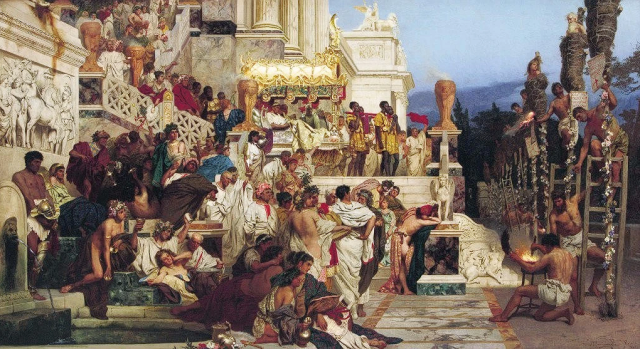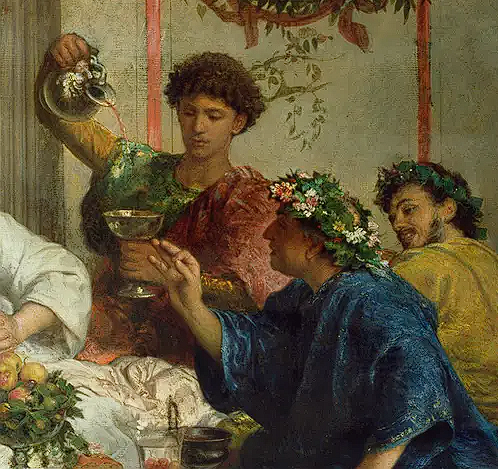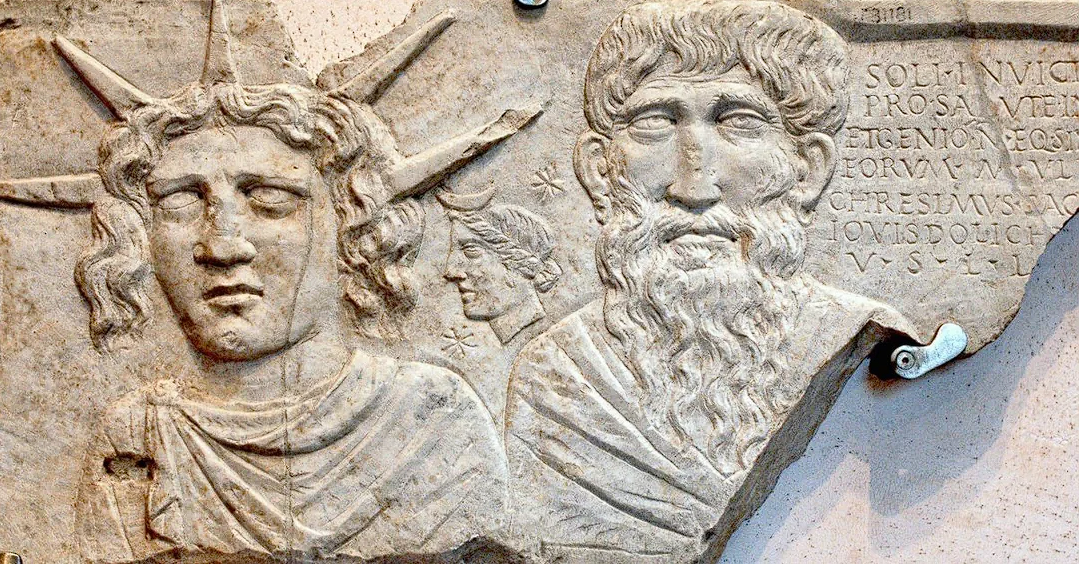
Ah, Christmas. That warm and fuzzy time of year when we deck the halls, exchange gifts, and sing about a jolly old man coming into our homes with a sack full of surprises. It’s the pinnacle of tradition, except it’s not entirely original. Strip away the tinsel and holly, and you’ll find something older, rowdier, and far more pagan lurking underneath: Saturnalia, the ancient Roman festival that is called by some “the Christmas before Christmas existed”.
With the holidays behind us, let us analyze the parallels between the two and figure just how much the Roman Empire inspired what we now refer to as “the most wonderful time of the year”.
For many historians, Christmas is the polished, family-friendly version of a debauched pagan bash. Sure, it’s now branded as a solemn celebration of the birth of Christ (we have the Romans to thank for that, as well), but if you look closely, you can choose to see many elements that were co-opted.
Satur-What?
First, let’s set the stage. Saturnalia was a week-long festival in honor of Saturn, the Roman god of agriculture and time. Officially, it ran from December 17 to December 23, though it often spilled over into an unofficial extended holiday.
The Romans celebrated Saturnalia by turning societal norms upside down. Slaves were temporarily freed and allowed to mock their masters, public gambling was encouraged, and a general atmosphere of “anything goes” prevailed. It wasn’t just a festival; it was a cultural exhale. After months of backbreaking labor, the people partied like there was no tomorrow (and with Roman mortality rates, there often wasn’t).
Sound familiar? That spirit of merriment, feasting, and social inversion has clear parallels to the modern Christmas season. After all, what is Christmas if not a chance to overindulge, embrace goodwill (even toward people you dislike), and pretend calories don’t count?
Decorations Then and Now
One of Saturnalia’s most enduring contributions to Christmas is the way we decorate our homes. During the festival, Romans adorned their houses with evergreen boughs, wreaths, and garlands—symbols of life persisting through winter. They even lit candles to brighten the darkest days of the year, a literal and symbolic nod to hope.
Fast-forward to today, and those same evergreen wreaths and twinkling lights have become staples of the Christmas aesthetic. Sure, we’ve upgraded to LED lights and plastic wreaths, made in China, that we fetch from supermarkets, but the core idea is identical.
The Original Art of Gift-Giving
If you think exchanging gifts is a purely Christian invention, think again. Saturnalia was the original Secret Santa. Romans exchanged small, symbolic gifts during the festival, such as candles, figurines, and sweets. These weren’t extravagant; the emphasis was on thoughtfulness rather than expense.
Now, compare that to today’s Christmas shopping frenzy. Somewhere along the way, we traded heartfelt tokens for overpriced gadgets and obligatory gift cards. Still, the act of giving—a hallmark of both holidays—comes directly from this Roman tradition.
Interestingly, early Christians weren’t too keen on the whole gift-giving thing. It was seen as too pagan and materialistic. But once the Church realized how much people loved the tradition, they conveniently rebranded it as part of Christmas. Because nothing says “holy night” like a new iPhone.
Feasting and Drinking – The Eternal Holiday Pastime

Saturnalia was essentially a seven-day banquet. Romans feasted on rich foods, drank copious amounts of wine, and let loose in a way that would make modern HR departments cringe. Sounds familiar? It should, because Christmas feasting is practically a carbon copy of this tradition.
Think of your average Christmas dinner. The choice of meat and sides may vary according to the region of Europe you stem from, but the table is always stacked with an impressive amount of calories. Now imagine doing that every day for a week, with fewer rules and more wine. That’s Saturnalia. Even the idea of communal meals, where everyone gathers around a table, owes a debt to this ancient festival.
The Calendar Shuffle, A Brilliant Conversion Strategy
Here’s the plot twist: Jesus wasn’t born on December 25. Or at least, there isn’t any theological/historical proof of the fact. The Bible doesn’t specify the date of Christ’s birth, and early Christians didn’t even celebrate it. So why December 25? Thank Saturnalia—and the Roman Empire’s knack for appropriation.
The date was strategically chosen by the Church to coincide with popular pagan festivals, including Saturnalia and the winter solstice celebrations of Sol Invictus, the “Unconquered Sun.” By aligning Christ’s birth with existing holidays, the Church made it easier for pagans to convert without giving up their favorite traditions. It’s a masterclass in marketing: if you can’t beat them, co-opt them.

What’s Left of Saturnalia?
While Saturnalia itself faded from history after the fall of the Roman Empire, its influence is everywhere, as is that of the romans that once ruled the world. Christmas could, essentially, be considered from a certain point of view, a Saturnalia with a nativity scene slapped on it. The spirit of indulgence, generosity, and togetherness remains, even if we’ve swapped Saturn for Santa Claus.
So the next time you are sipping mulled wine, unwrapping presents, or decorating your tree, spare a thought for Saturnalia. Without it, Christmas might never have become the glittery, gift-laden juggernaut of joy we know and love today.
There’s a delicious irony in the fact that Christmas—a holiday meant to celebrate the birth of Christ—is rooted in pagan traditions the Church once tried to eradicate. It’s a reminder that history isn’t a clean-cut narrative; it’s a messy, tangled web of influences and adaptations.
Long before the nativity story, the winter solstice was a major event for ancient cultures. The solstice, occurring around December 21 or 22 in the Northern Hemisphere, marked the longest night of the year and symbolized the rebirth of the sun. For societies heavily reliant on agriculture, this celestial turning point promised the gradual return of light and life.
Cultures around Europe held grand celebrations during this time. For instance, the Norse celebrated Yule, lighting massive bonfires and bringing evergreen trees indoors to symbolize eternal life. These evergreens would later evolve into the modern Christmas tree, while Yule logs became a cozy holiday tradition.
The practice of singing door-to-door during Christmas, known as caroling, has its origins in wassailing, a pre-Christian tradition. Wassailers sang songs to bless crops and orchards during winter, often accompanied by communal drinking. While modern caroling is less agricultural and more family-friendly, its origins in pagan rites of community and festivity are unmistakable.
Lighting candles during the darkest days of winter was a common pagan practice, symbolizing hope and the return of the sun. The Jewish festival of Hanukkah and the Roman Saturnalia both featured prominent use of light.
The timing and themes of hope and renewal from the solstice seamlessly aligned with Christianity’s message of Christ as the “light of the world,” making the transition to Christmas natural and the conversion of pagans easier.
In the end, Saturnalia’s legacy is a testament to the enduring power of celebration. Whether you call it Christmas, Saturnalia, or Festivus, the heart of the holiday remains the same: a time to come together, let loose, and embrace life. Just don’t forget to thank the Romans. They’d be thrilled to know their party never really ended.



 Subscribe
Subscribe